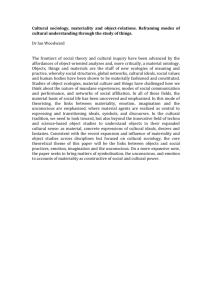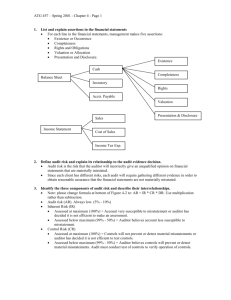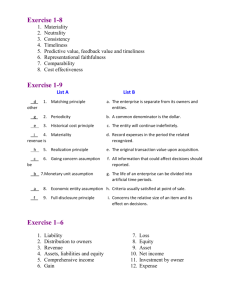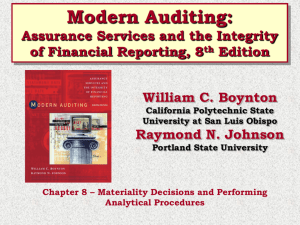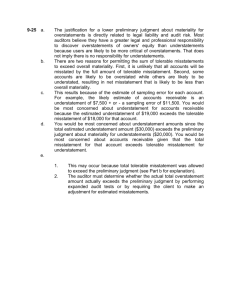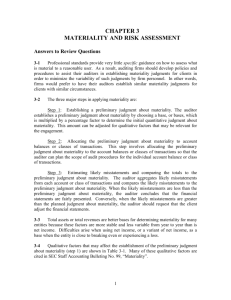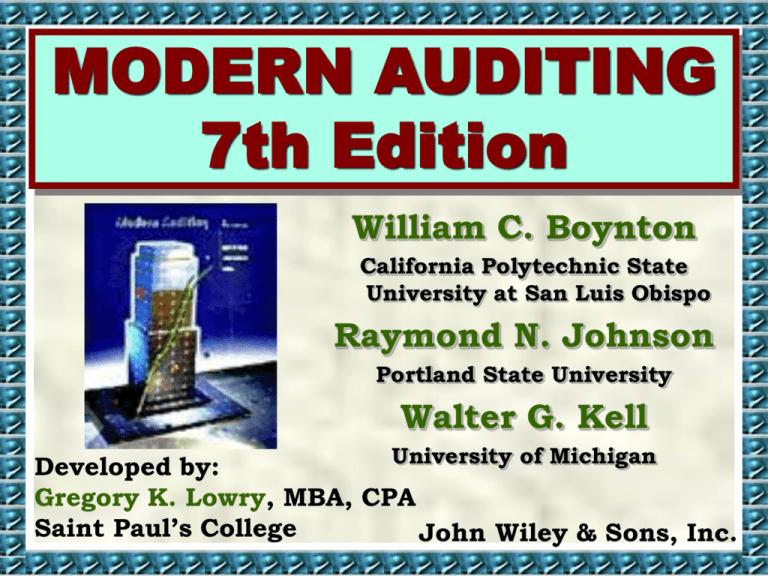
MODERN AUDITING
7th Edition
William C. Boynton
California Polytechnic State
University at San Luis Obispo
Raymond N. Johnson
Portland State University
Walter G. Kell
University of Michigan
Developed by:
Gregory K. Lowry, MBA, CPA
Saint Paul’s College
John Wiley & Sons, Inc.
CHAPTER 8
THE CONCEPT OF MATERIALITY
Materiality
Audit Risk
Preliminary Audit Strategies
The Concept of Materiality
The FASB defines materiality as
The magnitude of an omission or
misstatement of accounting
information that, in the light of
surrounding circumstances, makes it
probable that the judgment of a
reasonable person relying in the
information would have been changed
or influenced by the omission or
misstatement.
Preliminary Judgments About
Materiality
The auditor makes preliminary judgments
about materiality levels in planning the audit.
This assessment is referred to as planning
materiality, and may ultimately differ from the
materiality levels used at the conclusion of the
audit in evaluating the audit findings because:
1. the surrounding circumstances may
change and
2. additional information about the client will
have been obtained during the course of
the audit.
Preliminary Judgments About
Materiality
In planning an audit, the auditor should
assess materiality at the following 2 levels:
1. The financial statement level because
the auditor’s opinion on fairness
extends to the financial statements
taken as a whole.
2. The account balance level because the
auditor verifies account balances in
reaching an overall conclusion on the
fairness of the financial statements.
Materiality Levels Based on a Variable
Percentage of Total Assets or Revenue
Figure 8-1
If the Greater of
Total Assets or Revenue Is
Over
$
0
30 thousand
100 thousand
300 thousand
1 million
3 million
10 million
30 million
100 million
300 million
1 billion
3 billion
10 billion
30 billion
100 billion
300 billion
But Not Over
$ 30 thousand
100 thousand
300 thousand
1 million
3 million
10 million
30 million
100 million
300 million
1 billion
3 billion
10 billion
30 billion
100 billion
300 billion
Of Excess
Over
Materiality Is
$
0 + .059
1,780 + .031
3,970 + .0214
8,300 + .0145
18,400 + .0100
38,300 + .0067
85,500 + .0046
178,000 + .00313
397,000 + .00214
856,000 + .00145
1,840,000 + .00100
3,830,000 + .00067
8,550,000 + .00046
17,800,000 + .00031
39,700,000 + .00021
82,600,000 + .00015
$
0
30 thousand
100 thousand
300 thousand
1 million
3 million
10 million
30 million
100 million
300 million
1 billion
3 billion
10 billion
30 billion
100 billion
300 billion
Materiality at the
Financial Statement Level
Quantitative Guidelines
Currently, neither accounting nor auditing
standards contain official guidelines on
quantitative measures of materiality. The
following are illustrative of some guidelines used
in practice:
5% to 10% of net income before taxes (10% for
smaller incomes, 5% for larger ones)
1/2% to 1% of total assets
1% of equity
1/2% to 1% of gross revenue
A variable percentage based on the greater of
total assets or revenue
Materiality at the
Financial Statement Level
Qualitative Considerations
Qualitative considerations relate to the causes
of misstatements. A misstatement that is
quantitatively immaterial may be qualitatively
material.
Materiality at the
Account Balance Level
1. Account balance materiality is the
minimum misstatement that can exist in
an account balance for it to be considered
materially misstated.
2. Misstatement up to that level is known as
tolerable misstatement.
3. The concept of materiality at the account
balance level should not be confused with
the term material account balance.
Allocating Financial Statement
Materiality to Accounts
1. When the auditor’s preliminary judgments about
financial statement materiality are quantified,
a preliminary estimate of materiality for each
account may be obtained by allocating financial
statement materiality to the individual
accounts.
2. The allocation may be made to both balance
sheet and income statement accounts.
3. In making the allocation, the auditor should
consider:
a. the likelihood of misstatements in the
accounts and
b. the probable cost of verifying the account.
Relationship between Materiality
and Audit Evidence
1. It is generally correct to say that the
lower the materiality level, the greater
the amount of evidence needed.
2. It is also generally correct to say that
the larger or more significant an account
balance is, the greater the amount of
evidence needed.
The Audit Risk Model
Audit risk is the risk that the auditor
may unknowingly fail to appropriately
modify his or her opinion on financial
statements that are materially
misstated.
The audit risk model expresses the
relationship among the audit risk
components as follows:
AR = IR x CR x DR
The Audit Risk Model
SAS Nos. 39, 43, and 45 contain an
expanded audit risk model that
subdivides detection risk into 2
components.
AP for analytical procedures risk and
TD for tests of details risk.
Hence, the relationship among audit
risk components can be expressed as:
AR = IR x CR x AP x TD
Risk Components Matrix
Figure 8-2
Risk that Analytical Procedures
Will Not Detect Material Misstatements
Inherent Risk
Assessment
Control Risk
Assessment
High
Moderate
Low
Very Low
Maximum
Maximum
High
Moderate
Low
Very Low
Very Low
Very Low
Low
Very Low
Very Low
Low
Moderate
Very Low
Low
Moderate
High
Low
Moderate
*
*
High
Maximum
High
Moderate
Low
Very Low
Very Low
Low
Moderate
Very Low
Low
Moderate
High
Low
Moderate
High
*
Moderate
*
*
*
Moderate
Maximum
High
Moderate
Low
Very Low
Low
Moderate
High
Low
Moderate
High
*
Moderate
High
*
*
High
*
*
*
Low
Maximum
High
Moderate
Low
Low
Moderate
High
*
Moderate
High
*
*
High
*
*
*
*
*
*
*
Assessing the Components of
Audit Risk
1. Inherent risk is the susceptibility of an
assertion to a material misstatement,
assuming that there are no controls.
2. Control risk is the risk that a material
misstatement that could occur in an
assertion will not be prevented or
detected on a timely basis by the entity’s
internal controls.
3. Detection risk is the risk that the auditor
will not detect a mater misstatement that
exists in an assertion.
Interrelationships Among Materiality,
Audit Risk, and Audit Evidence
Figure 8-3
Alternative Preliminary Audit Strategies
Figure 8-4
4 Common Preliminary Audit Strategies
Figure 8-5
Relationship Between Strategies
and Transaction Cycles
The previously described strategies are
intended to characterize the audit
approaches for different assertions, not for
the entire audit.
Frequently, however, a common strategy is
applied to groups of assertions affected by a
transaction class within a transaction cycle.
Relationship Between Strategies
and Transaction Cycles
The following framework is representative of
practice:
Major Classes of Transactions
Cycle
Revenue
Sales, cash receipts, and sales adjustments
Expenditure
Purchases and cash disbursements
Personnel Services
Payroll
Production
Manufacturing of inventory
Investing
Investments in long-term assets or monetary investments of
excess cash
Financing
Financing from current long-term debt and capital stock
CHAPTER 8
THE CONCEPT OF MATERIALITY
Copyright
Copyright 2001 John Wiley & Sons, Inc. All rights
reserved. Reproduction or translation of this work
beyond that permitted in Section 117 of the 1976
United States Copyright Act without the express
written permission of the copyright owner is
unlawful. Request for further information should
be addressed to the Permissions Department, John
Wiley & Sons, Inc. The purchaser may make backup
copies for his/her own use only and not for
distribution or resale. The Publisher assumes no
responsibility for errors, omissions, or damages,
caused by the use of these programs or from the
use of the information contained herein.


